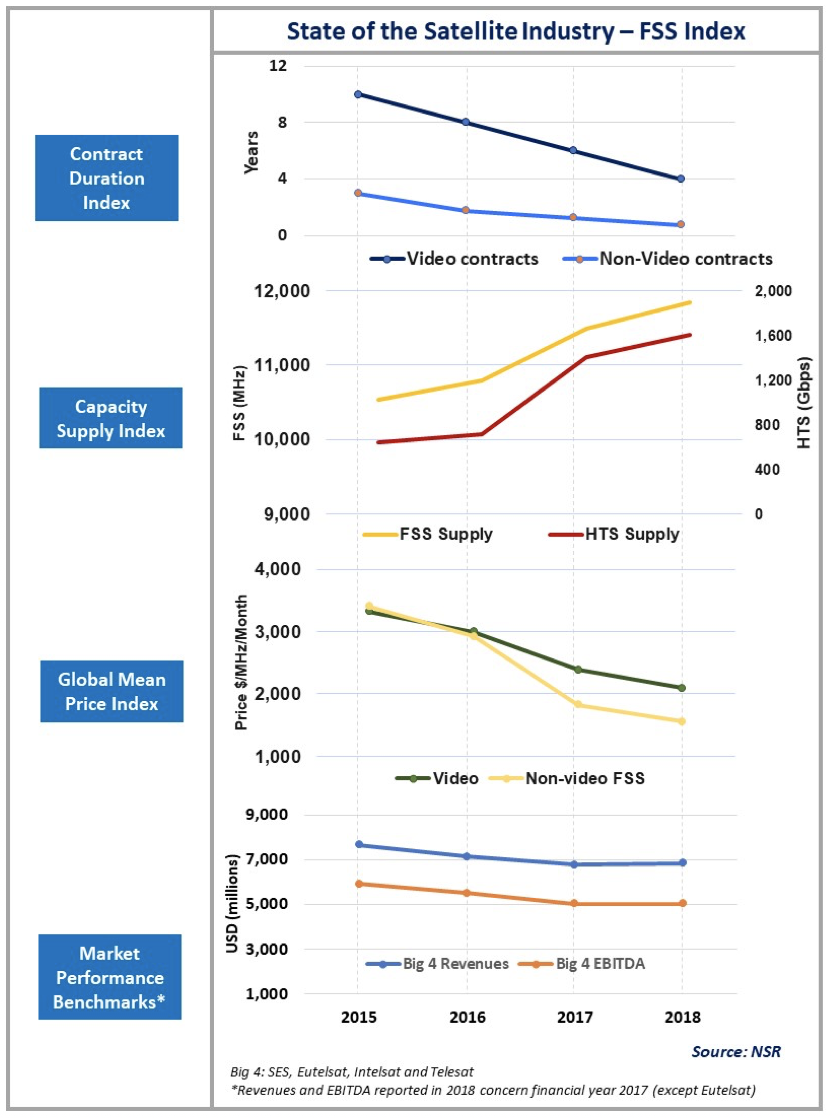State of the Satellite
Industry – The NSR FSS Index
Apr 15th, 2018 by Gagan Agrawal , NSR
Much has been commented about the current state of the
industry: capacity oversupply, declining capacity prices, a
shift to service businesses to strengthen top-line revenue,
partnerships with end-customers, and consolidation necessity
to future-proof. After a careful study of the past few
years, it is certain that most trends are true - reflecting
operator strategies as 2017 financial results show. Though,
less quantified is the effect on the FSS industry due to
these unanticipated changes in recent times. From FSS
wholesale price decline as analysed in NSR’s Satellite
Capacity Pricing Index, 4th
Edition, revenue and market cap erosion, to changing IRR
estimates of fleets older than 7 years, and eroding asset
value – the FSS industry definitely is in a state of
transition.
The chart below mentions 4
critical parameters defining industry progress. From 2015 to
2018, impact of contract duration, capacity supply, Global
Mean Price, and financial parameters such as revenues and
EBITDA are compared to build an “FSS Index”. The decline in
both video and non-video contracts is sharp and closely
mirrors the price decline over the same period.
Traditionally a shorter contract would mean a higher price,
although the corresponding increase in supply every year has
ensured the price correction upwards couldn’t occur.
While FSS capacity increased at ~14% over the past 3 years,
HTS capacity more than doubled during the same period. This
had an outsized influence over both relevance of FSS
capacity (barring certain maritime segments) and wholesale
pricing as shown in the Global Mean Price Index. Both
video and non-video pricing declines had direct influence
over top-line revenues of the Big 4 operators in the same
period. Simultaneously, HTS prices corrected sharply as
well, owing to lower CAPEX/Gbps capacity introduction, and
with operators starting to embrace a services model, the
EBITDA margins have started to come down as well. Thus, the
industry grapples with key questions on future growth.

As the graph shows, from 2015 to 1Q 2018, contract duration
decreased from an average 10 years to 4 years for video and
to less than 1 year for non-video. Global FSS capacity
supply increased by 14%, while HTS capacity increased almost
100%. Prices dropped by more than 50%, though revenues
for the Big Four dropped by only 10-11%. Most capacity deals
signed during the 2016-17 price decline period reflect
future revenue guidance for operators, thus only partly
affecting top line revenues from 2015 to 2018 reported
results. In the same period, demand for backhaul, broadband,
trunking, maritime, aero and high priced Gov/Mil sectors
increased, while video distribution and DTH in developed
markets lagged. Along with this demand uptake, there has
been a surge in managed services revenue for SES and
Intelsat side as well, covering video, maritime and Govt/Mil
sectors. The anticipation was always that this increase in
demand uptake, along with forays into managed services,
would propel top-line revenue (at least 5% growth), while
simultaneously checking the erosion of capacity pricing by
un-commoditizing it. This anticipation hasn't come true, and
capacity prices have fallen sharply due to competition,
resulting in this 10% revenue decline for Big 4.
Analysing 2018, the industry (for all purposes of growth and
stability) views HTS as the new messiah, whereas several
strategies have been touted by the industry to overcome the
slump. Prices for HTS capacity may still have more room to
decline, adjusting to bulk buying from service providers,
but FSS capacity appears to have reached precariously low
levels. Barring high SLA corporate networks and high-value
Energy segments, most capacity is sold at just above
break-even levels, with C-band going below break-even in
many cases. The future of the FSS market thus remains
non-sticky and unstable as capacity supply reaches beyond
12,000 36 MHz equivalent transponders in 2020. A few
critical factors are analysed below to ascertain the
buyer-seller dynamics in the past couple of years, and what
can be expected in the future:
-
Competition and Customer Retention: This is single
biggest influencing factor for the drop in aero and
backhaul prices in 2017, as there is an easing of
horizontal market share takeover and more focus on
downstream market share. Thus, customers are more
stable, ready to sign framework agreements for yearly
price negotiations and learning to differentiate between
value of ‘premium’ and ‘cheap’ capacity.
-
Value Chain Effect: PayTV subscriptions are bound to
have an adverse effect on Video Distribution and DTH
prices in developed markets, more recently witnessed
with the 5% fall of Western European hotspot pricing in
2017-18. Meanwhile, any service provider consolidation
is expected to further place pressure on wholesale
prices.
-
Technology Efficiency: Increasing spectral efficiency
will force operators to sell more Mbps, which in turn
will cannibalize less efficient FSS capacity. Expect the
data vertical to be the worst hit, both on pricing and
consequently on recovering break-even costs
Bottom Line: What to Expect in
the Future
Satellite markets inevitably are moving towards an
integrated approach, and it wouldn’t be surprising to see
falls in the contract duration index, Global Mean Price
Index and revenue/EBITDA margins further until 2020, before
a revenue rebound occurs. To understand the impact on FSS
and HTS markets, do reference NSR’s 2019 forecast prices.
Further, market cap and share prices are precariously placed
in the next 1-2 years, whereas dividend pay-out has sharply
decreased. Future CAPEX investments have also put some
operators on the brink of investment grade. Whether the next
generation of HTS and non-GEO satellites boosts top-line
revenues for the operator industry remains to be seen,
though certainly it is a tough road ahead for the FSS
segment.










